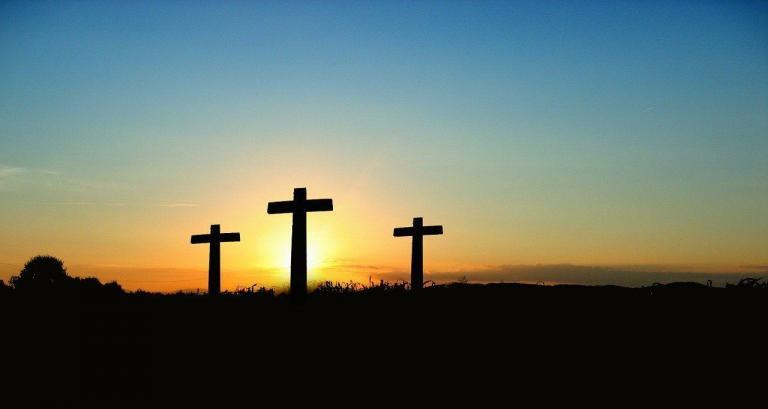
Holy Week Prophecies
The Big Picture – God will Redeem His Creation (Genesis 3:15): God had been giving the Israelites a picture of His plan for redemption really since the Garden of Eden, when He promised that the Seed of the woman would crush Satan’s head (Genesis 3:15; Romans 8:18-25; 16:20). Psalm 22, Isaiah 53, and much of the book of Zachariah reveal Christ’s passion. Consider these other pictures of redemption:
Abraham, and the “binding” of his son Isaac, (Genesis 22). God even led Abraham and Isaac to the specific hill (the future city of Jebus, and Jerusalem), where God would foreshadow His Own Son’s journey up that hill. We also note that Isaac carried the wood for sacrifice, similar to Jesus carrying the cross. In the end, Abraham said, “God Himself will provide the lamb for the burnt offering…” (Gn. 22:8); and God did, both right then, and in a much bigger way in Christ. Interestingly, it was Jesus – speaking as the Angel of the Lord (Jesus’ frequent used name in the Old Testament) – Who told Abraham and Isaac that He saw Abraham’s faith. Abraham would name that mountain: “The Lord Will Provide.” (Gn. 22:14)
Exodus Plagues and Passover (Exodus 5-15). We recall that them and protection which the Israelites experienced under Jacob’s son Joseph, soon disappeared and turned into captivity, and hardship. We remember that the New Testament tells us that Satan holds people “captive to do his will.” (II Tim. 2:26) The freedom that Satan offers is usually converted into some sort of captivity. (II Peter 2:19) there are numerous pictures of Jesus and the Exodus account:
1. The freedom of faith in the Gospel from the slavery of sin, in which Christ comes to bring us victory over Satan’s dominion, and sin’s curse – death, (John 8:31-34; Lk. 10:18; Gal. 5:1), is related to the freedom which the final plague in Egypt brought the Israelites (Exodus 12:31)
2. The unblemished Passover lamb – the final plague in Egypt was to be the plague of the firstborn males, including and beast. As a substitute, God provided a Lamb, which would die in place of any male child of the Israelites. The “unblemished” nature of that animal implied that it was similar to Christ who was “without sin.” (Hebrews 4:15; I Peter 1:19; I Cor. 5:7)
3. The blood as a sign – God told the Israelites to place the blood at the top and at the sides of each door, (marking the points of the future cross upon which Christ was crucified). God told the Israelites that the blood would be a sign “for you…” And then he added, “and when I see the blood, I will pass over you. No destructive plague will touch you when I strike Egypt.” (Exodus 12:13; Romans 3:25)
4. The Meal of Freedom and Protection for the Journey ahead – God was giving the Israelites a sign that the Passover would be the final of 10 plagues in Egypt. They were to eat it with the symbols of a journey: “loins girded, staff in hand, sandals on your feet.” (Exodus 12:11) Christ gave the Lord’s Supper as a sign of our own “exodus” from the captivity of sin (see “freedom” above), and our journey of faith, led by the Holy Spirit, just as the cloud and pillar of fire led the Israelites (Exodus 13:21,22; John 14:1-6, 31; II Corinthians 5:7; Galatians 5:1, 13-16). Holy Communion would be the new Passover, where Christians would receive strength for their own journey of faith, walking with the Spirit. (Galatians 5:25)
5. The Unleavened bread – a sign of the removal of sin (and the old slavery in Egypt, (Exodus 13:3). When Jesus warned the disciples to “watch out for the leaven of the Pharisees,” He was warning them to avoid the sin of self-righteousness, and all that “puffs up.” (Matthew 16:6, 11, 12; Luke 22:7) I Corinthians 5:7 is a powerful verse that reminds us we are “in fact unleavened” (because of Christ), but appeals to the faithful to remove sin/leaven daily.
6. The Darkness over the land – The penultimate plague in Egypt was 3 days of darkness (Exodus 10:21, 22). This was a sign that Yahweh was greater than the Egyptian sun god, Ra. It also foreshadowed Christ’s death, which was three hours of darkness (Luke 23:44)
7. The Simultaneous Punishment/Grace depicted in the crucifixion – Interestingly, the “Passover Lamb” was also permitted to be a “Passover Goat.” (Exodus 12:5) Through the symbol of the innocent lamb God was showing Christ and His goodness and mercy (John 1:29). But goats were a sign Jesus used to depict sin (Matthew 25:31-33). Jesus would be both Holy and imputed with our sin (Isaiah 53:7, 10; II Corinthians 5:21). The exchange of Jesus (held as guilty but clearly innocent) for Barrabas (clearly guilty but set free), points to both the redemption Christ was bringing, and the type of a “scapegoat” in Leviticus 16:10.
Palm Sunday -The Kingly Procession – on Palm Sunday the priests were typically inspecting lambs which had been brought by pilgrims, to be sacrificed and consumed in the Passover meal. The lambs were to be unblemished. At the same time Jesus would ride down the hill from the Mount of olives on the foal of a donkey, and the people were inspecting Him and finding him to be both Savior and King. “Blessed is the coming kingdom of our father David; Hosanna in the highest!” (Mark 11:10) The Palm Branches which people were holding up and placing before him, were political signs of an independent Israel healing Jesus as their King. Jesus would declare to the Roman governor Pontius Pilate “my kingdom is not of this realm.” His was a kingdom of peace over hearts by faith. (John 18:36, Matthew 16:16; Luke 10:21; Romans 10:9)
1. The prophecy of the King riding on the foal of a donkey (Zechariah 9:9-10) is a Messianic image of the King of Israel representing humble servanthood, and peace, (no horse was needed for war). Zachariah has so many pictures of the Messiah and passion week including God removing guilt in a single day (3:9); the crucifixion (12:10); the betrayal for 30 pieces of silver, and its use to buy a field (11:12-13); God dwelling in the land (2:10, 11; 8:3); God as temple/Church Builder (1:16 & Mt. 16:18), and the priest/king Joshua as a type of Christ (3:8, 9; 6:11). It was quoted by Jesus when He said “Strike down the Shepherd and the sheep will be scattered.” (13:7; Mt. 26)
2. Psalm 118 – Was a festival Psalm used for the three chief festivals, especially Passover. Pilgrims would sing the Psalm as they came up to Jerusalem, which is one reason why the Psalm was quoted on Palm Sunday. “O Lord, do save (Hosanna), we beseech You… Blessed is the one who comes in the name of the Lord…” (Psalm 118:25a, 26a). Jesus used the Psalm to tell the Passion week story in one verse: “And have ye not read this scripture; ‘The stone which the builders rejected is become the head of the corner, This was the Lord’s doing, and it is marvelous in our eyes?’ And they sought to lay hold on him, but feared the people: for they knew that he had spoken the parable against them: and they left him, and went their way.” (Psalm 118:22,23; Mk 12:10 – 12). The Psalm also emphasizes the Lord’s salvation and the festival sacrifice.
3. Isaiah 53 – Probably the most poignant picture of Jesus ministry, sacrifice, and resurrection in the Old Testament. Describing His suffering in detail, and receiving the guilt of others.
4. Holy week as a picture of God’s ultimate work in Christ for the world: Good Friday (the Passover) and reminding us of God’s completion of work as at Creation on the first Friday. Resting in the tomb Friday at sundown as full understanding of Sabbath “rest,” rising on Sunday, the first day of a new week (new creation), and also the Day of First Fruits a new season in the Jewish calendar, (Lev. 23); & our future resurrection prefigured (I Corinthians 15:20, 23)

